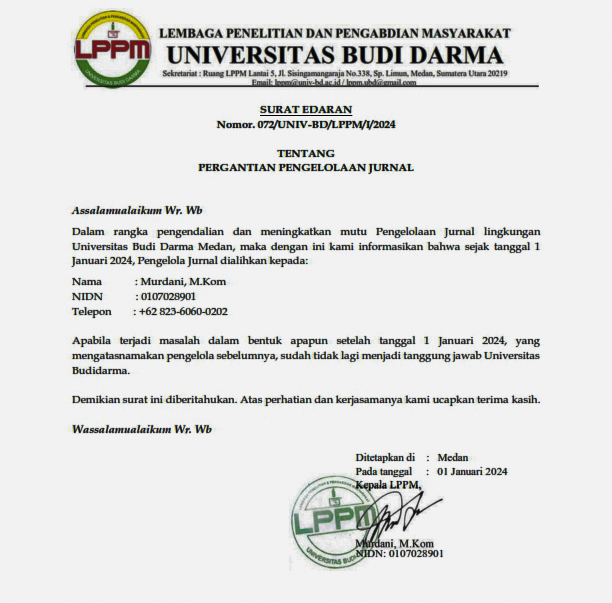PENGEMBANGAN MEDIA PEMBELAJARAN BERBASIS VIRTUAL REALITY UNTUK MENINGKATKAN HASIL BELAJAR PESERTA DIDIK SEKOLAH DASAR
DOI:
https://doi.org/10.30865/komik.v3i1.1662Abstract
Educators use various methods to explain the material so that learning objectives can be achieved, one of the methods is by utilizing learning media. The purpose of using learning media in learning activities is to facilitate communication and learning. The use of media in learning activities aims to attract the attention of students and strengthen their concentration when receiving material from educators.
The development of virtual reality media is an effort to realize educational goals. One of the success of learning lies in the ability of students' learning outcomes. Learning outcomes are very important for students as a benchmark of the extent to which students understand the material delivered by educators. Virtual reality media make learning outcomes the basis of development. The purpose of this study is to produce products in the form of virtual reality media to improve learning outcomes of elementary school students.This research is a development research with 4D development model from Thiagarajan. This development model consists of the stages define (design), design (design), develop (development), and disseminate (deployment). The research and development stage is carried out until the disseminate stage with the publication of articles and a trial process to students which is done on a limited basis. Data collection instruments in the form of a questionnaire distributed to experts in the material, media, and field application.Student learning outcomes of the experimental class and the control class can be concluded that the virtual reality-based learning media used in the experimental class are stated to be more effective and can improve student learning outcomes by a percentage of 100% while the control class gets 77.3%.
Keywords: learning media, virtual reality, learning outcomesReferences
Akbar, S. 2013. Instrumen Perangkat Pembelajaran. Bandung: PT Remaja Rosdakarya.
Alghamdi, A. & Kingdom, U. 2015. An Investigation of Saudi Teachers ’ Attitudes Towards IWBS and Their Use for Teaching and Learning in Yanbu. , 8(6), 539–554.
Anderson, L.R. & Kratwohl, D.R. 2001. A Taxonomy for Learning, Teaching, and Assesing: A Revision of Bloom’s Taxonomy of Eductional Objectives. A Bridged Edition. New York: Addision Wesley Longman, Inc.
Chou, C.C. 2017. An Analysis of The 3D Video and Interactive Response Approach Effects on The Science Remedial Teaching for Fourth Grade Underachieving Students. Eurasia Journal of Mathematics, Science and Technology Education, 13(4), 1059–1073. https://doi.org/10.12973/eurasia.2017.00658a.
Ghali, N.I., Soluiman, O., El-Bendary, N., Nassef, T.M., Ahmed, S.A., Elbarawy, Y.M. & Hassanien, A.E. 2012. Virtual Reality Technology for Blind and Visual Impaired People: Reviews and Recent Advances. Intelligent Systems Reference Library, 26, 363–385. https://doi.org/10.1007/978-3-642-23363-0_15.
González, M.M.A., Santos, B.S.N., Vargas, A.R., MartÃn-Gutiérrez, J. & Orihuela, A.R. 2013. Virtual Worlds. Opportunities and Challenges in The 21st Century. Procedia Computer Science, 25, 330–337. https://doi.org/10.1016/j.procs.2013.11.039.
Lv, Z., Li, X. & Li, W. 2017. Virtual Reality Geographical Interactive Scene Semantics Research for Immersive Geography Learning. Neurocomputing, 254, 1339–1351. https://doi.org/10.1016/j.neucom.2016.07.078.
Makransky, G., Lilleholt, L. & Aaby, A. 2017. Development and Validation of The Multimodal Presence Scale for Virtual Reality Environments: A Confirmatory Factor Analysis and Item Response Theory Approach. Computers in Human Behavior, 72, 276–285. https://doi.org/10.1016/j.chb.2017.02.066.
Motamedi, A., Wang, Z., Yabuki, N., Fukuda, T. & Michikawa, T. 2017. Signage Visibility Analysis and Optimization System Using BIM-Enabled Virtual Reality (VR) Environments. Advanced Engineering Informatics, 32, 248–262. https://doi.org/10.1016/j.aei.2017.03.005.
Rohani, A. 2014. Media Instruksional Edukatif. Jakarta: PT. Rineka Cipta.
Rutten, N., Van Joolingen, W.R. & Van Der Veen, J.T. 2012. The Learning Effects of Computer Simulations in Science Education. Computers and Education, 58(1), 136–153. https://doi.org/10.1016/j.compedu.2011.07.017.
Sadiman, A.S. 2014. Media Pendidikan, Pengertian, Pengembangan dan Pemanfaatannya. Jakarta. PT. RajaGranfindo Persada.
Smaldino, S.E., Deborah, L. & James, D. 2014. Instructional Technology and Media for Learning. Jakarta: Kencana Prenadamedia Group.
Sun, K. T., Lin, C.L. & Wang, S.M. 2010. A 3-D Virtual Reality Model of The Sun and the Moon For E-Learning At Elementary Schools. International Journal of Science and Mathematics Education, 8(4), 689–710. https://doi.org/10.1007/s10763-009-9181-z.
Thiagarajan, S., Semmel, D. & Semmel, M.I. 1974. Instructional Development for Training Teachers of Exceptional Children. Indiana: Indiana University





